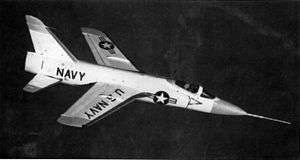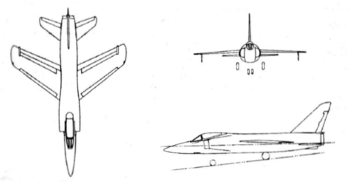Grumman F11F-1F Super Tiger
The Grumman F11F-1F Super Tiger (company designation G-98J) is a single-seat fighter aircraft originally developed for the United States Navy (USN). Based on the USN's F-11 Tiger, the F11F-1F did not proceed beyond the two F11F-1F prototypes.
| F11F-1F Super Tiger | |
|---|---|
 | |
| An F11F-1F Super Tiger prototype, with a General Electric J79 engine, in 1956 | |
| Role | Fighter aircraft |
| National origin | United States |
| Manufacturer | Grumman |
| First flight | 25 May 1956 |
| Status | Canceled |
| Primary user | United States Navy |
| Number built | 2 |
| Developed from | Grumman F-11 Tiger |
Design and development
As an improvement to the F11F-1 (F-11A) fighter, Grumman proposed a more advanced version of the airframe known as the F11F-1F Super Tiger. This was the result of a 1955 study to fit the new General Electric J79 engine into the F11F airframe. The Navy was sufficiently interested to authorize modification of two production F11F-1s with enlarged air intakes and YJ79-GE-3 turbojets, with the result being designated the F11F-1F, indicating a production F11F-1 with a special engine fit.
The aircraft first flew on 25 May 1956, reaching Mach 1.44 in one of the flights. After the addition of 60° wing root fillets, a 13.5 in (35 cm) fuselage extension, and an uprated J79 engine, the F11F-1F reached an impressive Mach 2.04 in 1957, thus becoming the first naval aircraft in the world to exceed Mach 2 (two years before the F4H, F8U-3, and A3J). This was a surprise even to Grumman, which had expected a top speed of only Mach 1.4 at altitude.[1] By comparison, the F11F-1 with the Wright J65 had had difficulty exceeding Mach 1.1. However, the U.S. Navy did not order the Super Tiger into production. Although the service ceiling of the aircraft was nominally 59,000 feet, a test flight on 18 April 1958 at Edwards AFB set a world altitude record of 76,939 feet.[2]
Operational history
Marketing efforts
Having failed to secure the Navy contract, Grumman marketed the Super Tiger to foreign customers. The Super Tiger outperformed the Saab Draken, Lockheed F-104 Starfighter, Dassault Mirage III, and Fiat G.91 in a tender to equip the Swiss Air Force. The Mirage III was finally chosen as a cheaper and more secure alternative, yet a close second in terms of performance.[3][4] In order to interest the Germans, Grumman proposed a 10,500 lbf Rolls-Royce Avon installation instead of the J79.[5]
The German Luftwaffe, Japan Air Self Defense Force, and Royal Canadian Air Force showed considerable interest but eventually the Lockheed F-104 Starfighter was chosen. This outcome, however, was marred by the Lockheed bribery scandals, in which huge sums were paid by Lockheed to influential politicians in those countries to ensure the adoption of the Starfighter.[6]
Variants
- F11F-1F Super Tiger
- (G-98J) Two Grumman F11F-1 aircraft fitted with J79-GE-3A engines, (BuNos 138646 and 138647).[1]
- F11F-2
- Intended pre-1962 designation of production Super Tigers.
- F-11B
- The post-1962 designation reserved for production Super Tigers.
- XF12F
- Semi-official designation for a developed version of the F11F-1F/-2.[7]
Aircraft on display
The first F11F-1F (BuNo 138646) was used for fire-fighting practice and destroyed in the 1980s. The second prototype (BuNo 138647) was retired on 10 January 1961 and used as a ground training aircraft. It is preserved on outdoor display at the China Lake Museum on loan from the Naval Air Weapons Station China Lake, California.[8]
Specifications (F11F-1F)

Data from Secret Projects: Fighters & Interceptors 1945-1978.[9]
General characteristics
- Crew: one
- Length: 48 ft 9 in (14.85 m)
- Wingspan: 31 ft 8 in (9.65 m)
- Height: 14 ft 4 in [10] (4.36 m)
- Wing area: 250 ft² (23.25 m²)
- Empty weight: 13,810 lb (6,277 kg)
- Loaded weight: 21,035 lb (9,561 kg)
- Max. takeoff weight: 26,086 lb (11,833 kg)
- Powerplant: 1 × General Electric J79-GE-3A turbojet
- Dry thrust: 12,533 lbf (53.3 kN)
- Thrust with afterburner: 17,000 lbf (75.6 kN)
Performance
- Maximum speed: Mach 2.04 (1,400 mph, 2,253 km/h[10]) at 40,000 ft (12,192 m)
- Range: 1,536 mi[10] (1,336 nmi, 1,826 km)
- Service ceiling: 59,000 ft[10] (17,980 m)
Armament
- Guns: 4 × 20 mm (.79 in) Colt Mk 12 cannon, 125 rounds per gun
- Hardpoints: 4 with a capacity of - and provisions to carry combinations of:
- Missiles: AIM-9 Sidewinder
See also
Related development
Aircraft of comparable role, configuration and era
Related lists
References
Notes
- Buttler 2008, pp. 114–115.
- "The New Navy 1954–1959" (PDF). Archived from the original (PDF) on 2000-09-14.
- "Die Besten: Supertiger und Mirage III (The Best Ones: Supertiger and Mirage III) (in German)." Archived 2011-06-25 at the Wayback Machine Schweizer Luftwaffe. Retrieved: 1 July 2010.
- "Le Supertiger et le Mirage III surclassent leurs concurrents (Supertiger and the Mirage III outclass their competitors) (in French)." Archived 2011-01-30 at the Wayback Machine Forces Aériennes Suisses. Retrieved: 1 July 2010.
- "P.1 German Demonstration." Flight, 31 January 1958, p. 130.
- Baugher, Joe. "Grumman F11F-1/F-11A Tiger." Joe Baugher's Encyclopedia of American Military Aircraft, 30 January 2000. Retrieved: 26 July 2010.
- Buttler 2008, p. 126.
- "F11-1F Super Tiger". China Lake Museum Foundation. Retrieved 2 April 2020.
- Buttler 2008, p. 135.
- Angelucci and Bowers 1987, pp. 250–251.
Bibliography
- Angelucci, Enzo and Peter M. Bowers. The American Fighter. Sparkford, UK: Haynes Publishing, 1987. ISBN 0-85429-635-2.
- Bowers, Peter M. United States Navy Aircraft since 1911. Annapolis, Maryland: Naval Institute Press, 1990, pp. 183–185. ISBN 0-87021-792-5.
- Buttler, Tony. American Secret Projects: Fighters & Interceptors 1945-1978. Hinckley, Leicestershire, UK: Midland Publishing, 2008, First edition 2007. ISBN 978-1-85780-264-1.
External links
![]()